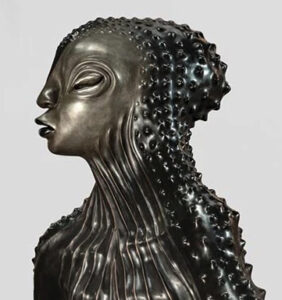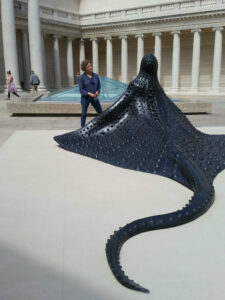I’m face to face with the bronze cast of a woman with full lips, cowrie-shaped eyes, and the body of a manta ray. We’re in the Legion of Honor’s neoclassical courtyard, where Rodin’s Thinker furrows his brow at the newcomers: a crocodile/human hybrid, two eerie prone figures at the foot of his pedestal, and the astonishing ray woman.
I’m thinking of how art shape-shifts through time, and of the giant rays of the Galapagos, highly intelligent and endangered animals that I saw through a dive mask a few years ago. They circled in the plankton-rich murk like enormous prehistoric birds that had traded sky for sea. The slow flapping of their fleshy fins left me with the kind of agitation we sometimes call awe.
Mama Ray, as the sculpture is called, is even more unsettling. The raised studs along its fins and tail send mixed messages: Stroke Me, and (as a sign warns) Do Not Touch. Mama Ray sweeps forward on the wing-fins of hybridity: it’s a woman, a sea creature, an alien, a sentinel, a battleship. It’s like nothing in nature but at the same time it reminds us of what we could be, of what we might once have been.
“Combining animals and humans, it’s as old as the human mind,” says Wangechi Mutu, the Kenyan artist who created Mama Ray.
When I was about 15, I had a dream that I remember to this day. I was dressing for a fancy party, in a strapless evening gown of emerald green silk. I thought I looked pretty good, even when I noticed my shoulders were covered in golden-brown fur. It was the softest, glossiest pelt I’d ever had the pleasure of petting. And pet myself I did. I was my own animal, a fox, maybe, or a regal German shepherd.
The pleasure I took in my own animal body in the dream was the polar opposite of how I usually felt. In waking life, our animal natures are often sources of shame. In my early teens I started getting furry, not just in the usual adolescent places but on my face as well. I was the daughter of a man so hairy he joked that he was the missing link between apes and humans. When he swam at public pools as a young man, kids would take one look at him and run screaming to their mothers.
I wasn’t that hairy, but my brows strained towards each other, my upper lip sprouted a soft fleece, and black, barb-like hairs grew in unlikely locales, as if for protection against growing up female.
At 15, I wasn’t ready for the radical message of a dream that told me to love my own animal self. I fought my hair, and my weight, too. I wish I’d had the same obsession with birds then that I now do. I would have known that birds binge before they migrate, gaining half again their body weight in a week or two, bulking up for the long weeks or months on the wing. What is adolescence if not a gearing up for the migration into adulthood?
But instead of accepting myself, I marched into battle, desperate to look more human and more feminine. My weapons were wax, chemical creams, and tweezers. In my 20s I saw an electrologist, aptly named Dawn, the perfect guide out of our animal past and into a hairlessly human future. She inserted needles into each follicle and then electrocuted the hair roots dead. It took a long time to make any progress. After each session my face was red and raw, and Dawn applied a foundation so thick it could probably disguise leprosy. It was that foundation that alerted the teenaged boys in my subway car that something was amiss with me. I think they assumed I was transgender or a cross dresser. They harassed me until I fled into the next car.
The world doesn’t want us to be more than one thing. But I think we want to be all sorts of things–man, woman, human and animal–with a deep longing that goes very far back.
“One of the first things we ever did,” says Mutu, “was to look at some creature and go, oh my gosh, I wish I had that speed, or power, or stealth, or courage.”
And how many of us have played the game, “If you could be any animal, what would you be?” Mutu’s sculptures, female figures with fins, tails, hooves, scales, webbed feet, and shells for ears, push that game even further. If you could be yourself and an animal, what would you be?
Mutu’s work speaks of so many things — racism, sexism, and colonialism, for starters. In a short but fascinating video, Mutu speaks about growing up in a Kenya still trying to shuck off its identity as a British colony. She learned the history and geography of England but very little about her own land and culture. In her work, she reclaims her Africanness, humanity, and femalehood, defining it in her own wildly imaginative hybrid terms.
Face to face with Mutu’s hybrid sculptures, I feel pride and power in my female human animality. Her work pushes the boundaries of our human minds and bodies. Why can’t we also be fish, and reptiles, and hooved animals that stampede the plain?
We need animals. We are animals. We need to have in our heads myths (or are they memories?) of when species intermingled, when we were more than our big brain and opposable thumbs. When we could breathe under water, fly through the air, or rip into our prey with yellowed fangs.
I wish the teenaged me had had a richer store of myth and imagination when it came to my own animal nature. Would I have let myself be furry? Probably not. But the shame would have been diluted, I think, and a storehouse of myth would have helped counteract the dominant culture, which values such a narrow range of beauty and humanity. Then, maybe, I could have kept up the dream of being both myself and my own dog.
I wish I were a hybrid

Mama Ray by Wenguchi Mutu
“It’s like nothing in nature but at the same time it reminds us of what we could be, of what we might once have been.”
